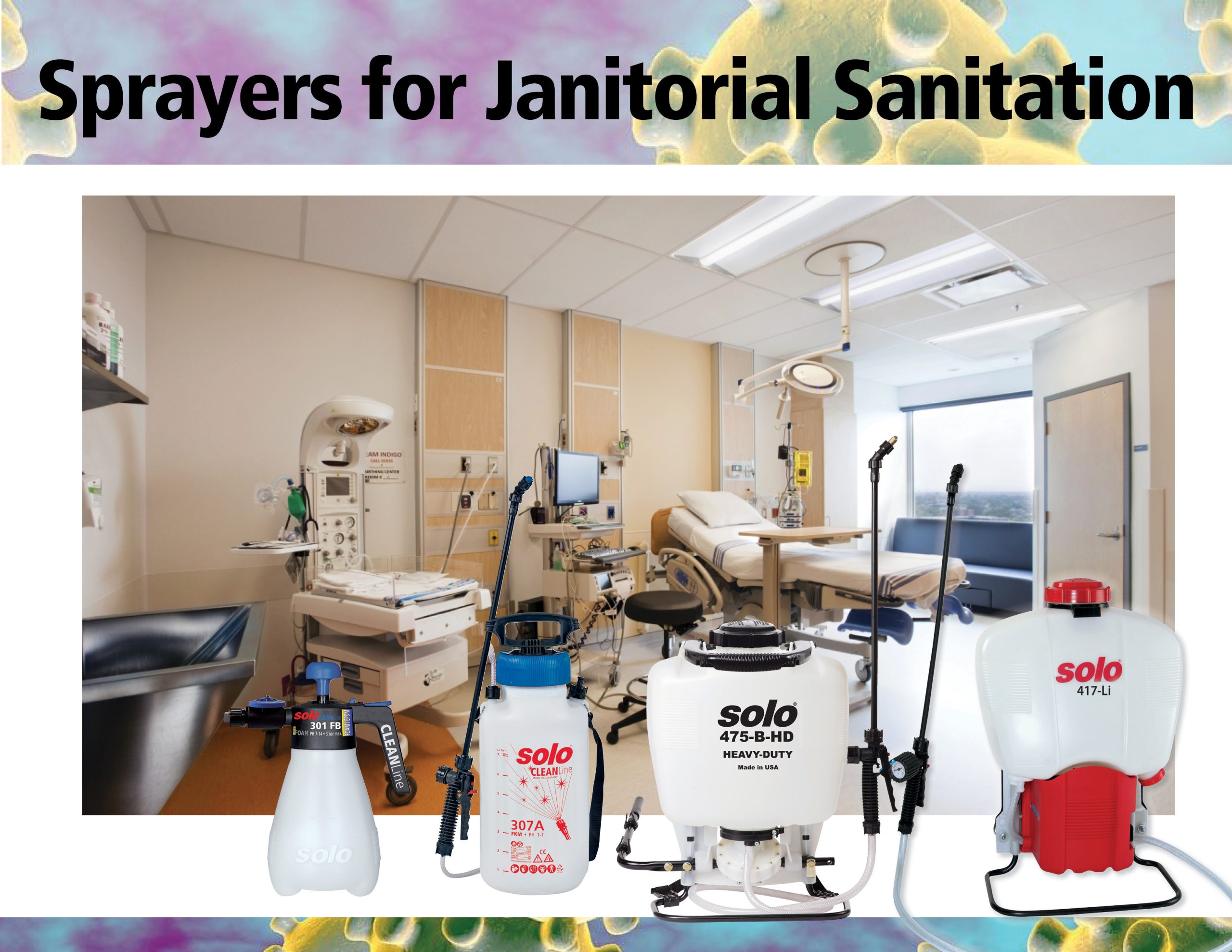
If there is anything a global pandemic can accomplish, it’s the ability to reveal the everyday objects on the periphery of public awareness that facilitate critical industries. Sprayers are one of those objects.
Back in December, before any of us understood the real threat of the coronavirus, we contemplated the unknown quality of our products. The situation has changed.
When we wrote that article in December, we talked about the versatility of sprayers. Solo creates sprayers for many industries, primarily in lawn and garden, but also in construction and janitorial sanitation. Solo’s sprayers are now in unusual demand for use in infection control.
That’s our goal today: we want to help you understand the downsides of trigger sprayers and help you choose the right janitorial sanitation sprayer for these difficult times.
The Downside of Trigger Sprayers
Trigger Sprayers
There are two issues with trigger sprayers: reduced worker productivity and inadequate chemical application.
Finger Fatigue
Finger fatigue is a common issue with trigger sprayers. In the short term, the repetitive depression of a trigger slows workers down. It takes longer for them to cover a surface thoroughly, and as a result, they move slower through the workday.
Over an extended period, workers may develop a condition called trigger finger. Trigger finger is caused by the repetitive movement or forceful use of your finger.
Inadequate Chemical Application
Another issue with trigger sprayers is inadequate chemical coverage due to user fatigue.
Benefits of Pump Sprayers
Pump sprayers offer solutions to the most common trigger sprayer problems. Pump sprayers eliminate the need to depress a trigger continually, reducing finger fatigue. Less finger fatigue allows employees to work faster and prevents injuries like trigger finger. They also offer better and faster chemical coverage, decreasing the risk of the outbreak of infectious diseases.
One-Hand Pump Sprayers
Solo’s CLEANLine one-hand pump sprayers are equipped with Viton® (“A”) or EPDM (“B”) seal options. Our A-series sprayers with Viton® seals throughout are compatible with acidic chemical solutions that are 1-7 pH, such as toilet bowl cleaners, solvents, bleach solutions, and rust removers. CLEANLine’s B-series sprayers are equipped with EPDM seals for alkaline chemical solutions that are 7-14 pH, such as disinfectants, carpet spot cleaners, window cleaners, bleach solutions, and degreasers.
The two seal variations offer the operator the ability to match the chemical solution and seal material, which promotes sprayer longevity.
Key Features
- Chemical compatibility ensures sprayer longevity.
- The efficient pump with a large handle reaches 45 psi quickly, which increases the speed and adequacy of chemical applications.
- The lock-on feature reduces finger fatigue.
- When set to the lowest setting, the plastic adjustable nozzle produces a fine mist clings to and wraps around a surface without saturating it.
Foaming Sprayers
Some cleaning solutions require dwell time to clean a surface effectively. Trigger sprayers cannot deliver foam, meaning that foaming cleaners cannot effectively clean a surface if dispersed with a trigger sprayer. Solo offers one-hand foaming sprayers that are equipped with our patented varioFOAM Adjustment System. With Solo’s varioFOAM sprayers, the operator can change moisture levels and foam consistency with the simple twist of a dial.
Handheld Sprayers
Bigger facilities require tools that get the job done efficiently. Schools, healthcare facilities, and many more environments require tools that can hold more chemical solution to cover larger areas.
Handheld sprayers can spray in hard-to-reach areas, and the user can work for longer periods without having to refill the tank repeatedly. Here are some key benefits of using a handheld sprayer:
- Solo’s 53″ long hose and 20″ wand enables the user to spray further without having to carry the sprayer constantly.
- Large tank capacity is ideal for disinfecting larger facilities.
Backpack Sprayers
Manual Backpack Sprayers
- Manual backpack sprayers are a great option for professional users. Here are some key benefits of using manual backpack sprayers:
- Solo’s backpack sprayers come equipped with a plastic adjustable nozzle that, when turned to the furthest fine mist setting, produces an even distribution of chemical solution on a surface.
- The operator can achieve a spray-and-go application, which is the preferred disinfection technique during this pandemic.
- Solo’s manual backpack sprayers also have an internal pressure cylinder that holds about 1 liter of formulation within a 4-gallon tank. This is the only amount of formulation that is being pressurized at any time.
- The ergonomic design of the unit is such, whereas the pump handle is situated at a 90-degree angle to the operator’s dominant hand. As the operator is walking the area to be treated, the pumping is performed at the operator’s pace.
Battery-Powered Sprayers
Battery-powered backpack sprayers are one of Solo’s most sought-after products by professionals in many different industries.
For the professional user, battery-powered backpack sprayers offer many benefits:
- Battery-powered backpack sprayers are free of emissions and are whisper quiet.
- They are designed for a variety of spraying tasks, including enclosed spaces such as greenhouses and office buildings.
- Perfect for when extended spraying applications are required.
- Just as with manual backpack sprayers, battery-powered sprayers can produce a fine mist that covers a surface evenly.
Sprayers are Important for Adequate Chemical Application
Adequate chemical application is crucial for a healthy and clean environment, and the sprayer you use makes all the difference in achieving even chemical coverage. The adequate application of chemicals is important when disinfecting.
